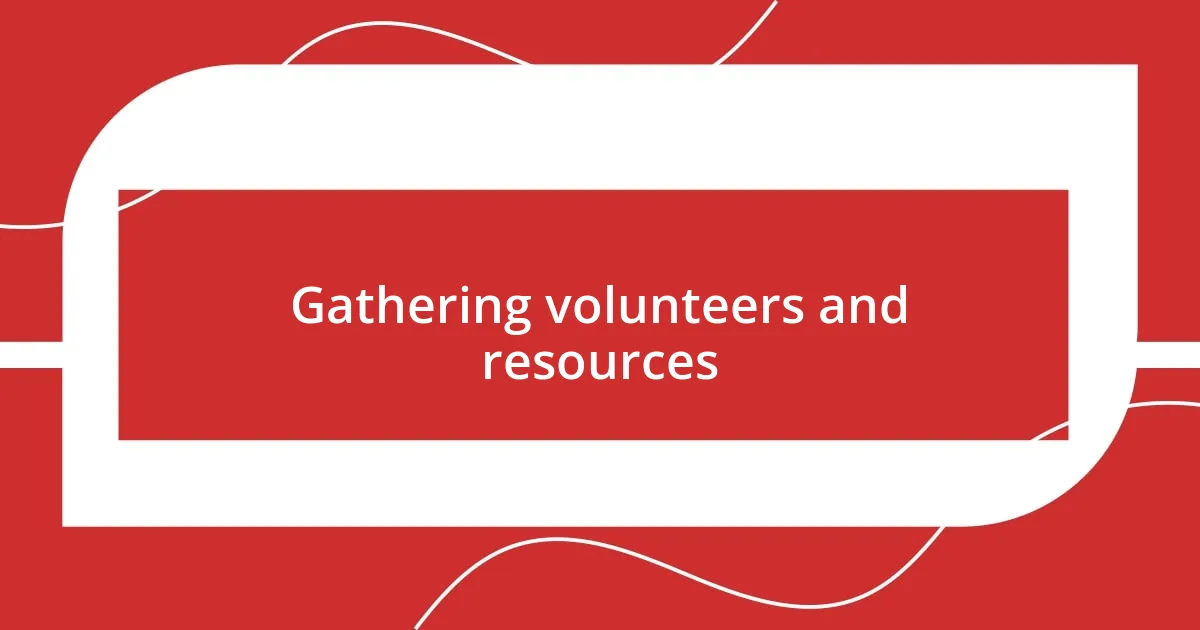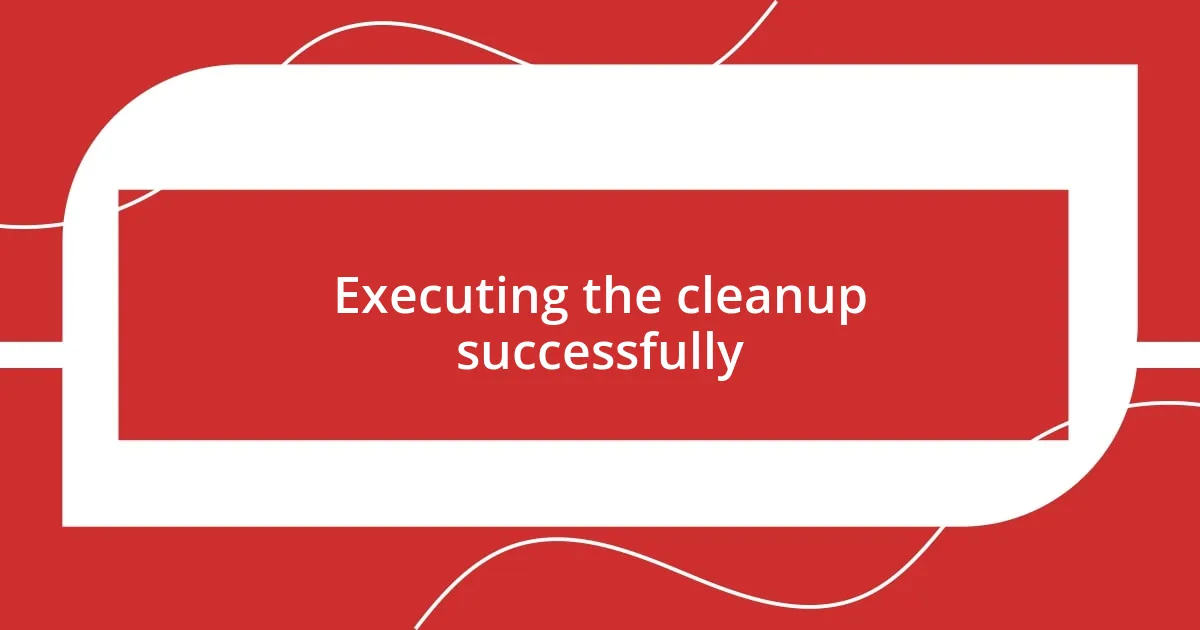Key takeaways:
- Community cleanups foster a sense of ownership and pride among residents while promoting environmental education and awareness.
- Effective planning includes defining clear objectives, coordinating tasks, and gathering feedback to improve future events.
- Engaging volunteers and local businesses enhances community spirit and resource availability for cleanups.
- Post-event evaluation and sharing success stories can inspire continued community involvement and promote sustainability efforts.

Understanding community cleanups
Community cleanups are a powerful way to bring people together for a common cause. I still remember my first cleanup; it was a chilly Saturday morning, and as I arrived, I was struck by the variety of people gathered—families, friends, and even those I had never met. Isn’t it amazing how a shared passion for our environment can unite us?
Beyond just picking up litter, cleanups change the way we see our neighborhoods. When I started organizing these events, I was surprised by the emotional impact they had on participants. There’s something empowering about transforming a neglected space into a clean, welcoming area. Have you ever felt that thrill of making a difference, even if it’s just a small park?
Understanding community cleanups also means recognizing the ripple effects they create. Each event sparked conversations about local environmental issues, fostering a sense of pride and responsibility among residents. It’s a moment when we can collectively ask ourselves: how can we continue this momentum long after the cleanup is over? That reflection pushes us to think about sustainability in our daily lives.

Importance of community cleanups
The importance of community cleanups goes far beyond just picking up trash; it cultivates a sense of ownership among residents. I recall a cleanup event where we all rallied around a local park that had once felt neglected. Watching the smiles and laughter as we transformed it into a beautiful space was nothing short of magical. It was clear that the participants developed a deeper connection to their environment, and the park soon became a place that everyone felt proud to cherish.
Consider these key impacts of community cleanups:
- Community bond: Bringing together diverse groups fosters friendships and networks.
- Environmental education: Participants learn about pollution and its effects firsthand.
- Increased awareness: Cleanups spark discussions about sustainability and environmental issues.
- Pride in ownership: A clean area motivates residents to take care of it in the long run.
Through these events, I witnessed how a simple act of cleaning can lead to long-lasting community change. It’s incredible how an afternoon spent picking up litter can ignite a passion for ongoing environmental stewardship. Each cleanup instills a renewed spirit in all of us, reminding us that together, we can create a beautiful and sustainable world.

Planning an effective cleanup
Planning an effective cleanup begins with clear objectives. When I first organized a cleanup, I was so eager to get started that I didn’t define what we wanted to achieve. Would we focus solely on litter picking, or should we also include educational components? Setting specific goals helped channel efforts, making the day both productive and enjoyable.
Another essential aspect is coordination and communication. I learned the hard way that sending out reminders and outlining tasks leads to smoother events. For instance, when volunteers understand their roles—like trash collectors, recyclers, or logistics coordinators—it fosters teamwork. Everyone feels more engaged, and it elevates the overall experience.
Lastly, it’s important to gather feedback post-event. I’ve made it a habit to ask participants what they enjoyed and what could improve. Their insights have been invaluable. After one cleanup, I was pleasantly surprised to hear volunteers suggesting a follow-up meeting to discuss ongoing efforts. This shows how effective planning can lay the foundation for future initiatives and keep the community spirit alive.
| Planning Steps | Considerations |
|---|---|
| Define Objectives | What are we looking to achieve? Sustainability? Community bonding? |
| Coordinate Tasks | Assign clear roles to volunteers for better teamwork. |
| Gather Feedback | How can we improve the next event based on participants’ suggestions? |

Gathering volunteers and resources
Engaging volunteers is one of the most rewarding parts of organizing a community cleanup. I remember reaching out to local schools and community organizations, and the enthusiasm was palpable. It’s amazing how just a simple invitation can ignite interest—people want to contribute to something bigger than themselves. Have you ever experienced that moment when someone tells you they’re excited to join? It makes all the effort worthwhile!
Collecting resources is equally important. I’ve found that local businesses are often willing to contribute, whether it’s through donations of supplies or snacks for the volunteers. In one instance, a nearby grocery store donated bottled water and snacks for everyone. This small gesture made a huge difference and fostered a sense of community support. It’s heartening to see how businesses can rally around local initiatives, enhancing both their visibility and community spirit.
Being prepared doesn’t stop at just gathering people and materials. I’ve learned to create a checklist of items we would need—trash bags, gloves, and first-aid kits. On my first cleanup, I was caught off guard when we ran out of bags halfway through! Since then, I always ensure we have more than enough. Have you ever faced a hiccup during an event? It’s these moments that teach us to be proactive and resourceful, ensuring a smoother experience for everyone involved.

Promoting the cleanup event
Promoting a cleanup event can truly make a difference in rallying the community together. I remember posting announcements on social media and the excitement that followed. The shares and comments poured in, turning a small event into something larger than I had imagined. It’s fascinating how a digital nudge can create a wave of enthusiasm—have you ever noticed how a single post can inspire friends to join in? I love how interconnected we can become, all for a shared purpose.
In my experience, word of mouth is one of the most powerful tools for promotion. I found that when I personally reached out to friends and local groups, their response was overwhelmingly positive. Often, it’s that personal touch—a friendly phone call or a one-on-one chat—that sparks genuine interest. There was an instance when I bumped into a neighbor who, after hearing my plans, decided to gather her family to volunteer. It’s moments like these that remind me that grassroots connection is key to building momentum.
Lastly, I’ve discovered that collaborating with local influencers can amplify your message significantly. Once, I partnered with a well-known blogger who agreed to promote our event. It was eye-opening to see how their followers engaged with the content. So, have you considered reaching out to people who already have a platform? This strategy not only broadens your outreach but also validates the event. I’ve learned that people are often eager to support community initiatives, especially when they see their favorite local figures involved.

Executing the cleanup successfully
Executing a cleanup requires careful planning and coordination. I remember my first cleanup day vividly; it was like orchestrating a symphony. As we gathered at the park, I realized that clear communication was crucial. I assigned roles based on each volunteer’s strengths, which helped everyone feel like their contributions mattered. Have you ever noticed how efficiency skyrockets when responsibilities are well-defined? It fosters teamwork and boosts spirits.
The day of the event is an exhilarating mix of energy and anticipation. I still smile thinking about a time when our group found a hidden stash of litter in a secluded area. It felt amazing to collectively uncover that mess and leave the area cleaner than we found it—there’s something deeply satisfying about that! I love how even the smallest successes can ignite motivatiom. It’s about more than just cleaning; it’s about making a lasting impact. Have you ever experienced that rush of accomplishment when your team comes together?
It’s also important to end the event on a high note. On one occasion, we organized a small celebration with snacks and a group photo. Reflecting on our day’s achievements not only reinforced our collective effort but also left everyone with a positive memory. I believe that recognition plays a big role in community building. If you’ve ever helped with a project, how did you celebrate the accomplishments afterward? Those moments solidify connections and inspire future participation.

Evaluating the cleanup experience
Evaluating the cleanup experience provides a unique opportunity to reflect on what truly worked and what can be improved for future events. After each cleanup, I take a moment to gather feedback from participants, often over coffee or during a casual chat while we’re still exhilarated from our efforts. It’s fascinating to hear diverse perspectives; did you know that sometimes the simplest tasks can bring the most joy? For example, a friend mentioned how much she enjoyed connecting with nature while picking up trash, which reminded me of the deeper reasons we volunteer.
Another essential aspect I focus on is assessing the impact of our efforts. After one particularly large cleanup, we decided to take “before and after” photos of the areas we worked on. The transformation was incredible! Sharing these images not only showcased our hard work but also inspired others in our community to take similar initiatives. Have you ever doubted whether your small actions made a difference? Those visual representations told a powerful story and sparked conversations about sustainability that went beyond our event.
I also encourage participants to share what they’d like to see in future cleanup events. In one instance, a volunteer suggested incorporating more educational elements about waste management. This inspired me to invite local experts for future cleanups to talk about environmental conservation. It’s these moments of collaboration and shared ideas that truly enrich our experiences. How often do you get to be part of a collective movement that not only beautifies your surroundings but also educates and empowers? It’s a rewarding journey that I continually cherish.















